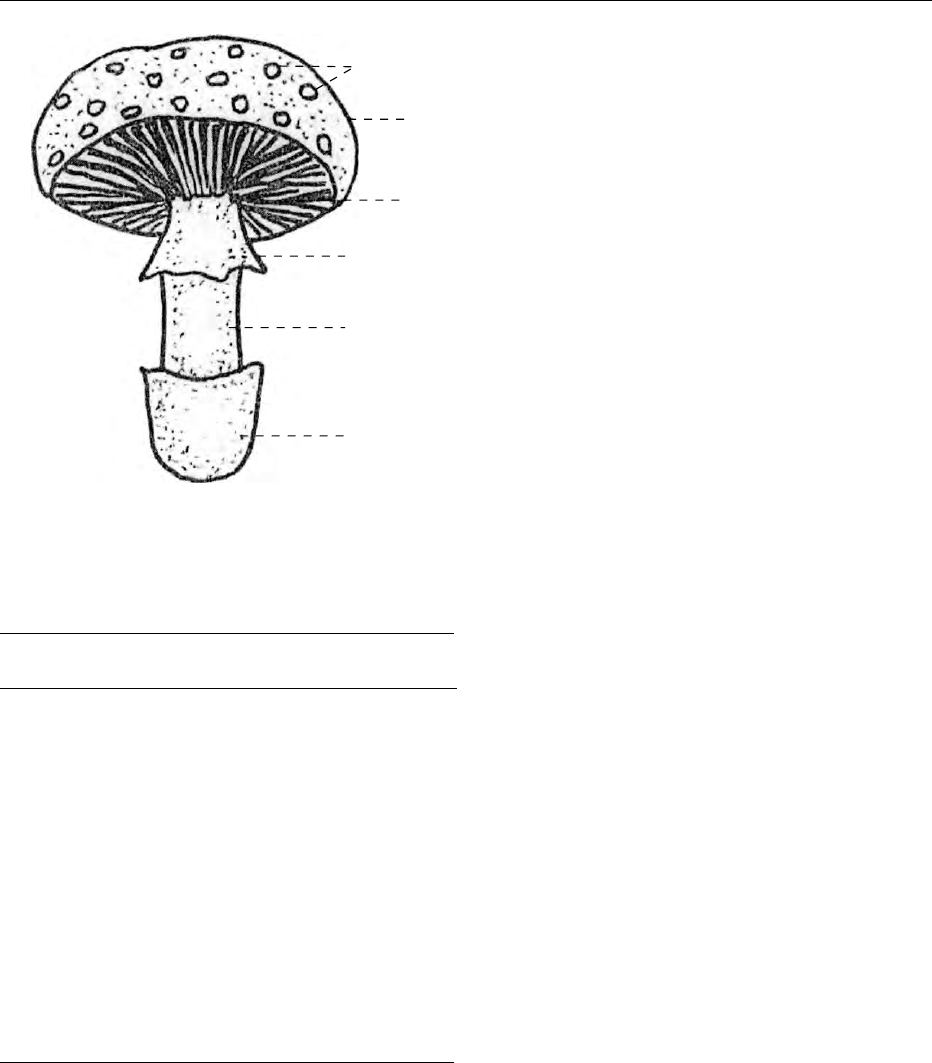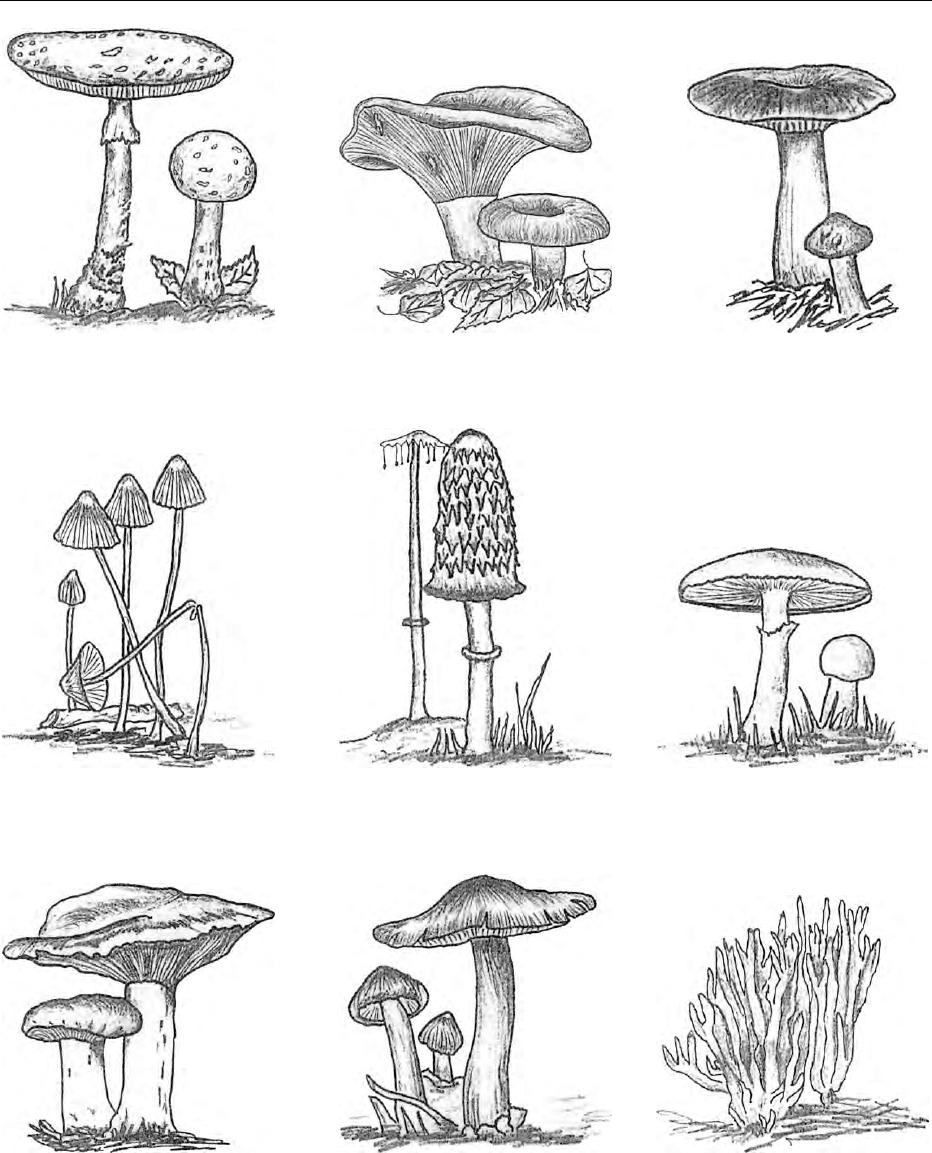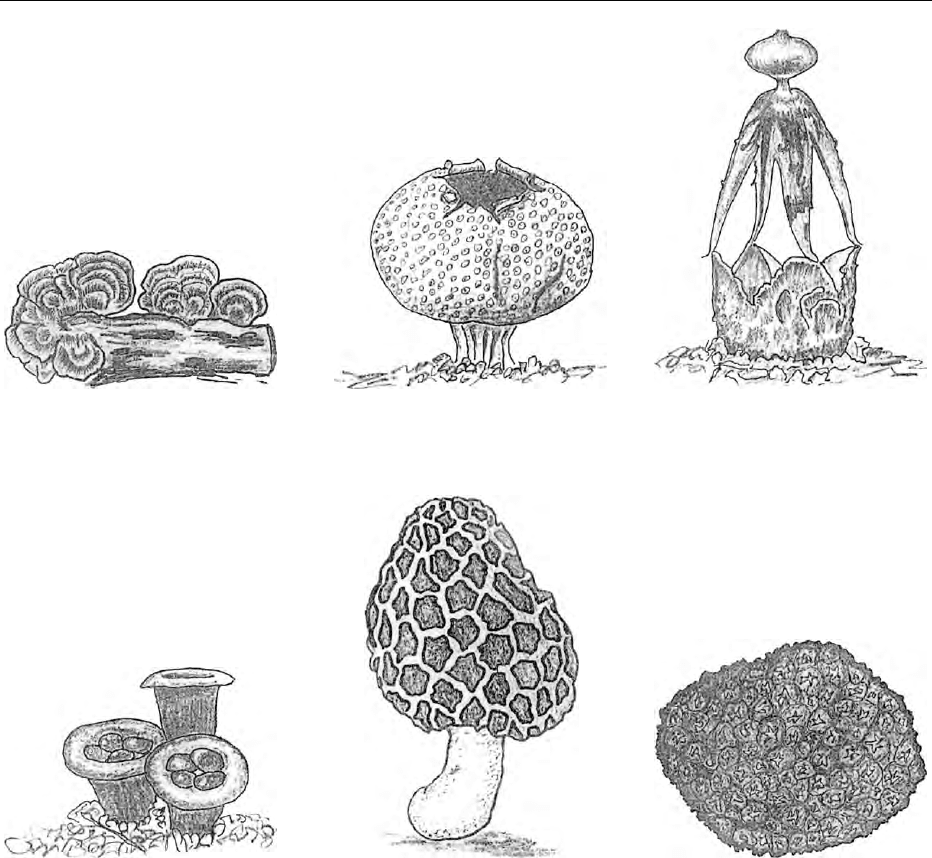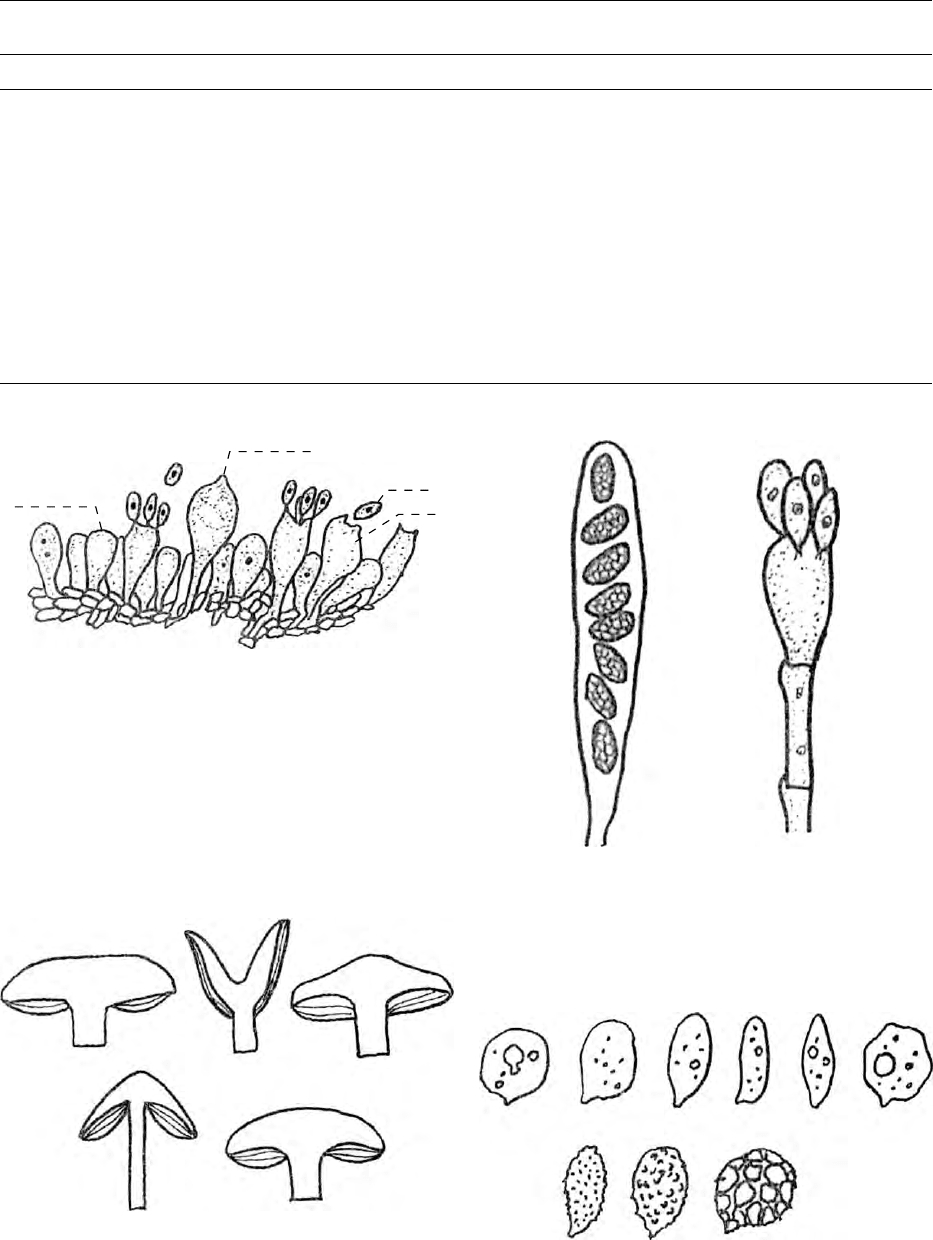Caballero B. (ed.) Encyclopaedia of Food Science, Food Technology and Nutrition. Ten-Volume Set
Подождите немного. Документ загружается.


Basidiomycetes, the basidiospores are formed ex-
ogenously on the basidia (Figure 10).
0031 Ornamentation of basidiospores The color of the
spore print immediately after collection of a species
may help to identify a species. Basidiospores are of
various colors, shapes, sizes, and arrangements
(Figure 11). In fact, they are one of the most useful
features in mushroom taxonomy. They may be hya-
line and thin-walled, as in Agaricus and Pleurotus, set
for immediate germination; they cannot carry out the
function of surviving to the next season. In some
cases, they are thick-walled and variously orna-
mented to survive to the next season and also result
in effective dissemination. Peridioles of Cyathus
species exemplify a special mode of dissemination,
that is effected by a drop of rain water. In fact, basi-
diospores of various mushroom species are micro-
scopic objects of ornamentation on the earth
(Table 4).
0032Vegetative reproduction Several mushroom species
multiply using structures other than asco- or basidios-
pores (Table 5). Oidia represent thin-walled asexual
spores that participate in germination. Chlamydo-
spores are thick-walled spores produced vegetatively
from mycelial cells, that resist the unfavorable condi-
tions and germinate under the onset of favorable
conditions. Sclerotia are thick-walled, conspicuous
mycelial tufts of different sizes. These provide an
easier means of producing the fruiting bodies in
Morchella.InPleurotus tuber-regium, the sclerotium
carries out the function of sustaining during unfavor-
able weather conditions. Thus, mushroom species, as
the mostly highly evolved of the fungi, have reminis-
cent characteristics of primitive fungi, which have
served to prolong the life cycle and create alternative
means of perpetuating the species.
Importance of Identification and Classification
0033Identification of mushrooms is a very difficult job in
mycology, and the specimens collected, because of
their delicacy, should be handled with care. Marking
the characteristics of the species in situ in nature for
shape, size, color, flavor, and latex, if any, and collect-
ing spore print are essential in the field/forest or zone/
area of collection. Further identification rests on the
spore morphology and, to some extent, on the char-
acteristics of the mycelium. It may be easy in some
cases to assign the correct class, order, and family to
mushrooms collected in the field, but assigning a
genus and species requires more knowledge. If it is a
new species, more interest would be evinced in under-
standing the edibility, life cycle, growth substrate,
periodicity of fructification, enzymes secreted, and
possibility of artificial culturing and any special fea-
ture in reducing environmental pollution by biodeg-
radation of toxic compounds. Thus, the identification
and classification of mushroom species may be diffi-
cult but sometimes rewarding.
0034The Royal Botanical Gardens, in Kew, London
maintains records of all species discovered to date.
Another dimension of natural collection of any mush-
room species, its identification and characterization,
tbl0002 Table 2 Variations in morphology
Characteristics Present (þ)/
absent ()
Mushroom
species
Edible/
poisonous
Annulus Volvariella volva cea Edible
Amanita vaginata Poisonous
Annulus þ Agaricus bisporus Edible
Agaricus xanthodermus Poisonous
Volva Agaricus bisporus Edible
Scleroderma citrinum Poisonous
Volva þ Volvariella volva cea Edible
Amanita crocera Inedible
Both þ Lepiota procera Edible
Amanita porphyria Poisonous
Both Russula virescens Edible
Lactarius helvus Poisonous
Stipe central Agaricus compestris
Russula cyanoxantha
Stipe excentric Pleurotus florida
Polyporus squamosus
Stipe absent Tremella mesenterica
Hirneola auricula-judae
f
e
d
c
b
a
fig0006 Figure 6 Structure of a typical mushroom. (a), volva; (b), stipe;
(c), annulus; (d), gills; (e), pileus; (f), scales (remnants of univer-
sal veil).
4044 MUSHROOMS AND TRUFFLES/Classification and Morphology

(a) (b) (c)
(d) (e) (f)
(g) (h) (i)
MUSHROOMS AND TRUFFLES/Classification and Morphology 4045

involves the maintenance of its culture in viable
but importantly vigorous. Often, the culture may
be viable but cannot yield to fructification on growth.
In the American Type Culture Collection in Rock-
ville, USA, identified mushroom cultures can be
deposited and given a code number. This has led to
a centralized system in which mushroom cultures
from any area of the world can be deposited and
made available for study, which would not otherwise
be possible if species/cultures were lodged only with
collectors.
Poisonous Mushrooms
0035It is very difficult to state whether a mushroom is
poisonous or edible. Traditionally, mushroom species
have been classed as ‘poisonous,’ nonfatal but causing
stomach upset, termed ‘inedible,’ and ‘edible.’
0036At present, animal-feeding trials are the best way
to identify the poisonous varieties, but some of the
characteristics relating to poisonous species are:
.
0037bright-spored, with both annulus and volva – Ama-
nita spp.;
(j) (k) (l)
(m) (n) (o)
fig0007 Figure 7 Morphological variations of mushrooms and truffles. (a) Amanita muscaria; (b) Lactarius turpis; (c) Russula sardonia; (d)
Mycena galopus; (e) Coprinus comatus; (f) Agaricus campestris; (g) Tr i c h o l o m a g a mb o s um ; (h) Entoloma clypeatum; (i) Calocera viscosa; (j)
Coriolus versicolor; (k) Scleroderma citrinum; (l) Geastrum fornicatum; (m) Cyathus olla; (n) Morchella esculenta; (o) Tuber melanosporum.
4046 MUSHROOMS AND TRUFFLES/Classification and Morphology

tbl0003 Table 3 Coloration of various mushroom species
Color Edible Poisonous
Red/brick red deep reddish brown Russula nigricans Amanita muscaria
Yellow/greenish yellow yellowish red Amanita citrina Hypholoma fasiculare
Tremella mesenterica
Light brown/brown/coffee brown Polyporus squamosus Scleroderma citrinum
Hygrophorus hypothejus Paxillus involutus
Grayish/grayish brown Amanita vaginata Amanita porphyria
Boletus scaber
Orange/orange red Boletus grevillei Boletus satanas
Lactarius deliciosus
Violet/purple blue Lepista nuda Mycena pura
Russula cyanoxantha
Green Russula virescens Amanita phalloides
White Clitocybe nebularis
Agaricus bisporus
abc
de
fig0009 Figure 9 Orientation of gills in mushrooms. (a) free gills with
shallow convex cap; (b) decurrent gills with funnel-shaped cap;
(c) adnate gills with campanulate cap; (d) adnexed gills with
conico-campanulate cap; (e) sinuate gills for cap with incurved
margin.
ab
fig0010Figure 10 Ascus and basidium. (a) ascus with ascospores;
(b) basidium with basidiospores.
ab
gh i
cdef
fig0011Figure 11 Shape and ornamentation of the basidiospores.
(a) globular; (b) oval; (c) ellipsoid; (d) cylindrical; (e) fusoid;
(f) angular; (g) echinulate; (h) warted; (i) reticulate.
a
b
c
d
fig0008 Figure 8 Structure of the hymenium. (a) paraphysis; (b) cysti-
dium; (c) basidiospore; (d) basidium.
MUSHROOMS AND TRUFFLES/Classification and Morphology 4047

.0038 oozing yellow latex on rupture of the surface –
Psalliota xanthoderma;
.
0039 spore print turning greenish (copper compounds) –
Lepiota morgani;
.
0040 luminescent – Clitocybe illudens.
See also: Mushrooms and Truffles: Use of Wild
Mushrooms; Mycotoxins: Classifications; Occurrence
and Determination; Toxicology
Further Reading
Alexopoulos CJ (1961) Introductory Mycology. London:
John Wiley.
Chang ST and Quimio TH (eds) (1982) Tropical Mush-
rooms – Biological Nature and Cultivation Methods.
Hong Kong: Chinese University Press.
Chang ST, Buswell JA and Miles PG (eds) (1993) Genetics
and Breeding of Edible Mushrooms. Philadelphia, USA:
Gordon & Breach.
Christensen CM (1969) Common Edible Mushrooms.
Minneapolis, USA: The University of Minnesota Press.
Elliott TJ (1985) The general biology of the mushroom. In:
Flegg PB, Spencer DM and Wood DA (eds) The Biology
and Technology of the Cultivated Mushroom. New
York: John Wiley.
Hard ME (1976) Mushrooms, Edible and Otherwise. New
York: Dover.
Largent DL (1973) How to Identify Mushrooms to Genus.
1: Macroscopic Features. Eureka, CA: Mad River Press.
Rajarathnam S and Zakia B (1987) Pleurotus mushrooms.
Part IA. Morphology. life cycle, taxonomy, breeding,
and cultivation. CRC Critical Reviews in Food Science
and Nutrition 26(2): 157–223.
Rajarathnam S, Shashirekha MN and Zakia B (1992) Bio-
potentialities of the Basidiomacromycetes. Advances in
Applied Microbiology 32: 234–361.
Ramsbottom J (1989) Mushrooms and Toadstools.
London: Bloomsbury Books.
Singer R (1961) Mushrooms and Truffles. New York: Inter-
science.
Svrc
ˇ
ek M (1975) Mushrooms and Fungi. London: Octopus
Books.
Wilkinson J and Buczacki S (1982) Mushrooms and Toad-
stools. Glasgow: Harper Collins.
Use of Wild Mushrooms
S Rajarathnam and M N Sashirekha, Central Food
Technological Research Institute, Mysore, India
Copyright 2003, Elsevier Science Ltd. All Rights Reserved.
Background
0001Mushrooms were regarded by the early civilizations
of Egypt and Rome as a special delicacy and were
perceived by the Romans as the food of the gods.
A clear indication of the high esteem in which mush-
rooms were held by different cultures is provided by
the practice of restricting the use and consumption of
many species to the rulers of the time. The medicinal
and analeptic qualities of mushrooms, the scientific
basis for which we are only just beginning to under-
stand, have long been appreciated by the Chinese.
Legend states that Chinese emperors consumed
Lentinus edodes in large quantities to fend off old
age. Other accounts tell us that the ancient Japanese
courts valued these mushrooms for their aphro-
disiac properties. ‘The growing sites were well
hidden and heavily guarded.’ One species of mush-
room, Ganoderma, is cultivated today strictly for its
medicinal benefits. It is now realized that mush-
rooms have an important role to play in the recycling
of organic wastes, thereby relieving environmental
pollution.
Useful Chemical Constituents
0002Mushrooms are known for their characteristic biting
texture and pleasant aroma. These properties have
derived the meaning for mushrooms as items of food
delicacy. In recent years, it has been well proven
and documented in the world literature that mush-
rooms do provide definite nutrition and health bene-
fits for humans. Significant compositional changes
occur with a strain as a result of differences in age
tbl0004 Table 4 Morphology of spores of various mushroom species
Shape Mushroom species
Globular Helvella elastica, Pseudohydnum gelatinosum
Oval Paxillus involutus, Pholiota squamosa
Ellipsoid Collybia dryophila
Cylindrical Polyporus squamosus, Calocera viscosa
Fusoid Inonotus hispidus
Angular Entoloma sinuatum
Echinulate Laccaria laccata, Cortinarius mucosus
Warted Peziza badioconfusa, Ramaria aurea
Reticulate Lactarius volemus, Lactarius helvus
tbl0005 Table 5 Forms of vegetative reproduction
Types Mushroom species
Oidia Pleurotus cystidiosus
Chlamydospores Agaricus spp.
Volvariella spp.
Sclerotium Morchella esculenta
Pleurotus tuber-regium
4048 MUSHROOMS AND TRUFFLES/Use of Wild Mushrooms

or stage of development, lapse of time after harvest,
study of different portions of a single fruiting body,
the inaccuracies inherent in the methods of analysis,
and the relative precision of the analyst. In order to
insure universal comparison of the analytical values
of different workers, it is worth expressing all the
analytical data on dry weight of the fruiting bodies,
since it is well known that mushrooms in general
contain about 90% moisture in fresh form. Mush-
rooms on a dry-weight basis contain 63% carbohy-
drates, 25% protein, 4% fat, and the remaining 8% is
accounted by minerals represented by ash (Table 1).
Most carbohydrates are in the polymeric form, glu-
can and hemicellulose types; starch as such is absent.
Mannitol and trehalose represent the bulk of free
sugars. Accordingly, the energy value is also relatively
less. Mushrooms do contain considerable amounts of
dietary fiber.
0003 Protein represents the major fraction next to
carbohydrates. The fraction 4.38 is used to convert
nitrogen into mushroom protein (instead of the
general factor 6.25), excluding nonprotein nitrogen
in the form of chitin present in the cell walls.
Albumins and globulins predominate in the protein
fraction of Boletus edulis and Cantharaellus cibarius.
Free amino acids account for nearly one-fifth of the
total nitrogen. Protein is made up of most of
the essential amino acids; however, some essential
sulfur-containing and aromatic amino acids are
lacking. Based on the amino acid analysis, several
indices are used to predict the nutritional quality of
the mushroom.
0004Mushrooms are relatively low in fat content. The
fat includes representatives of all classes of lipid com-
pounds, including free fatty acids, mono-, di-, and
triglycerides, sterols, sterol esters, and phospholipids.
There is a preponderance of unsaturated fatty acids,
in particular linoleic acid (78% of the total fatty
acids). It is the degree of unsaturation of fatty acids in
mushrooms that reflects on their safety in consump-
tion without any danger of atherosclerosis.
0005The ash is mainly composed of calcium, potassium,
phosphorus, and ferrous iron (Table 2). Some species
also contain germanium, which is known for main-
taining vitality in humans. Mushrooms have a special
feature of bioaccumulation of minerals available in
their growth medium. This property is useful in pro-
viding desired minerals in good quantities. When they
accumulate toxic elements, they become dangerous
for consumption.
tbl0001 Table 1 Composition
a
of mushrooms
Mushroom species Crude protein (N 4.38) Fat Carbohydrate Fiber Ash Energy value (kcal)
Agaricus bisporus 26.3 1.8 59.9 10.4 12.0 328
Auricularia auricula-judae 8.1 1.5 81.0 6.9 9.4 356
Boletus edulis 29.7 3.1 59.7 8.0 7.5 362
Cantharellus cibarius 21.5 5.0 64.9 11.2 8.6 353
Coprinus comatus 25.4 3.3 58.8 7.3 12.5 366
Flammulina velutipes 17.6 1.9 73.1 3.7 7.4 378
Lentinus edodes 17.5 8.0 67.5 8.0 7.0 387
Lycoperdon lilacinum 46.0 7.5 38.8 12.3 7.7 358
Pholiota nameko 20.8 4.2 66.7 6.3 8.3 372
Pleurotus florida 18.9 1.7 58.0 11.5 9.3 265
Termitomyces microcarpus 27.4 4.3 54.2 2.2 14.1 364
Tr i c h o l o ma species 16.7 3.1 71.9 12.9 8.3 342
Volvariella esculenta 34.4 20.6 31.7 11.2 13.3 396
a
On a dry-weight basis.
tbl0002 Table 2 Mineral content
a
of mushrooms
Mushroom species Ca P K Fe
(mg100 g
1
)(mg100g
1
)(mg100g
1
)(ppm)
Pleurotus florida 24 1850 4660 184
Agaricus campestris 23 1429 4762 186
Volvariella diplasia 58 1042 3333 177
Lentinus edodes 118 650 1246 30.3
Flammulina velutipes 19 278 2981 11
Pholiota nameko 42 771 2083 22
Auricularia polytricha 287 Trace 47
Tricholoma matsutake 26 640 41 417
a
On a dry-weight basis.
MUSHROOMS AND TRUFFLES/Use of Wild Mushrooms 4049

0006 Mushrooms are a good source of several vitamins.
Species of Pleurotus are estimated to contain pre-
dominantly vitamins of B-complex and folic acid.
Relative to Auricularia, Lentinus, and Volvariella,
the thiamin, niacin, and riboflavin content of Pleur-
otus species were higher (Table 3). Considering the
amount of vitamins contributed by 100 g fresh Pleur-
otus mushrooms as a percentage of the requirement
level indicated by the Food and Agriculture Organ-
ization/World Health Organization (FAO/WHO)
per person per day and allowing for differences in
moisture contents, Pleurotus mushrooms are a
particularly good source for meeting the human
requirements for riboflavin and folic acid (Table 4).
0007 Mushrooms are known for their B-complex vita-
mins (niacin, thiamin, and B
12
) and folic acid. Their
ability to contain these vitamins, even during their
growth on lignocellulosic wastes, eventually substan-
tiates their biosynthetic capacities. In fact, folate
synthetase and B
12
synthetase enzyme systems have
been demonstrated in mushroom cells.
Food Value
0008 Determination or prediction of the nutritional value
of mushrooms (Table 5) has been made possible
based on their content of essential amino acids.
0009 The amino acid score is the amount of the most
limiting amino acid in the food protein expressed as a
percentage of that amino acid present in a reference
protein.
Amino acid score ¼
mg of amino acid in 1 g test protein
mg of amino acid in 1 g reference protein
100
0010The essential amino acid (EAA) index evaluates the
quality of dietary protein in terms of the ratio of the
EAA contained in a food, relative to the EAA content
of the reference protein, mostly egg.
EAA ¼
ffiffiffiffiffiffiffiffiffiffiffiffiffiffiffiffiffiffiffiffiffiffiffiffiffiffiffiffiffiffiffiffiffiffiffiffiffiffiffiffiffiffiffiffiffiffiffiffiffiffiffiffiffiffiffiffiffiffiffiffiffiffiffiffiffiffiffiffiffiffiffiffi
Lysine
p
tryptophan
p
histidine
p
Lysine
s
tryptophan
s
histidine
s
n
s
where p ¼food protein, s ¼standard (egg), and n ¼the
number of amino acids.
0011The biological value is a measure of the nitrogen
retained by the body after consuming the test protein.
Biological value ¼ 10:9 ðEAA indexÞ11:7
0012In an attempt to resolve the difficulties inherent in
comparisons between those mushrooms containing
small amounts of high-quality protein with those
containing larger amounts of a protein of lesser nutri-
tional quality, the use of a nutritional index has been
proposed:
Nutritional index ¼
EAA indexpercentage protein
100
0013Amino acid scores and EAA indices of the most
nutritive mushrooms (highest values) rank in poten-
tial nutritive value with those of meat and milk, and
are significantly higher than those for most legumes
and vegetables. The least nutritive mushrooms rank
appreciably lower but are still comparable to some
common/nutritious vegetables.
As Flavor Ingredients
0014In general, mushroom flavor substances are deriva-
tives of fatty acids and nucleotides. Flavor is the most
tbl0003 Table 3 Vitamin contents of mushrooms
Mushroom species Ascorbic acid
a
Thiamin
a
Niacin
a
Riboflavin
a
Pantothenic acid
a
Folic acid
b
Pleurotus florida 113 1.36 72.9 7.88 29.4 1412
Agaricus bisporus 82 1.14 56.19 4.95 22.8 933
Auricularia auricula-judae 0.16 4.10 0.48
Lentinus edodes 0.40 11.90 0.90
Volvariella volvacea 0.32 59.5 2.73
Flammulina velutipes 46.3 6.10 5.2 106.5
Pholiota nameko 18.8 72.9 14.6
a
mg 100 g
1
dry mushrooms.
b
mg100g
1
dry mushrooms.
tbl0004 Table 4 Vitamins contributed by 100 g fresh Pleurotus
mushrooms as a percentage of the daily requirement
recommended by the Food and Agriculture Organization/World
Health Organization (FAO/WHO)
a
per person
Ascorbic acid Thiamin Niacin Riboflavin Folicacid
Adult man 24–43 10–15 26–33 33–39 53–60
(30) (1.2) (19.8) (1.8) (0.2)
Adult women 24–43 13–19 36–46 46–54 53–60
(30) (0.9) (14.5) (1.3) (0.2)
a
Report of a Joint FAO/WHO Expert Group (1974) Rome: FAO.
Note: Figures in parentheses are values in mg recommended intake by
FAO/WHO per person per day.
4050 MUSHROOMS AND TRUFFLES/Use of Wild Mushrooms

important inducement for past and present wide-
spread consumption of wild and commercially
grown edible mushrooms. As many as 150 volatile
compounds have been identified in various mush-
room species. A series of eight carbon (C
8
) com-
pounds are believed to be the most important
volatile flavor compounds. It has been demonstrated
that some of the C
8
and C
10
compounds can be enzy-
matically formed from linoleic and linolenic acids,
both of which are usually predominant in fruiting
bodies. The gills were found to be the major compart-
ment for the metabolic interconversion of fatty acids
into aromatic compounds. 1-Octen-3-ol is the general
fresh mushroom flavor, whereas 1-Octen-3-one
represents the dried-mushroom flavor. Several alco-
hols, aldehydes, ketones, and phenols are known to
be mushroom flavor components characteristic of
each species.
0015 Umami, the full, rounded taste (as defined by the
Japanese) of a mushroom, is predominantly the result
of the presence of monosodium glutamate, further
improved with addition of minor amounts of nucleot-
ides, such as guanidine monophosphate (GMP) and
adenosine monophosphate (AMP). Tricholomic acid
and ibotenic acid have been found in Tricholoma
muscarium and Amanita pantherina, respectively.
These amino acids have higher threshold values than
that of glutamic acid in evoking the umami flavor. It is
of great interest that these two amino acids are toxic to
flies. A Japanese proverb states that the Tricholoma
matsutake is noted for its aroma and Lyophyllum
shimeji is noted for its taste. The aroma components
of T. matsutake are matsutakeol and methyl cinna-
mate. A sulfur-containing compound, lenthinic acid,
in fresh Lentinus edodes is flavorless, but it is con-
verted by heat to lenthionin, which is responsible for
the specific flavor, when L. edodes is dried.
As Source of Enzymes
0016 Mushrooms are involved in the rotting of wood.
Studies have been performed on many enzymes
produced by cultured mushroom mycelia internally
or externally. Mushrooms (basidiomycetes and a part
of ascomycetes) are generally divided into lignin-
hydrolyzing fungi (oxidoreductase producers) and
cellulose-hydrolyzing fungi (hydrolase producers). In
addition to phenol oxidase and cellulase, there are
many reports on other mushroom enzymes, including
protease, pectinase, chitinase, hemicellulase, amylase,
and various glycosidases.
As Indicators of Toxic Elements
0017Mushrooms have a natural tendency to bioaccumu-
late the minerals from their growth substrates.
Agaricus campestris finds use as a bioindicator
species to trace the concentrations of silver. Phanero-
chaetae chrysosporium was most effective in sorption
of lead compared with species of Polyporus, Volvar-
iella, and Pleurotus. Coprinus species is shown to be
able to methylate mercury after the transformation of
mercury from the soil humus. The ability of several
mushroom species to bioaccumulate cadmium, zinc,
lead, copper, nickle, and manganese in their fruiting
bodies is employed to monitor the intensity of envir-
onmental pollution. Several toxic metals are select-
ively sorbed from industrial waste waters by
mushrooms. Inonatus nikadol is used to recover ur-
anium selectively from the culture medium.
Biological Uses
0018Many mushrooms, such as Ganoderma lucidum,
Coriolus versicolor, Hericium erinaceus, Armillaria
mellea, Marasmius androsaceus, Tremella fuciformis,
and Lentinus edodes, have traditionally been used as
medicine and tonics in China, Korea, and Japan
(Tables 6 and 7). Terpenoids, substances which
inhibit growth of cancer cells such as He La cells
in vitro (chemotherapeutic agents), have been found
in Ganoderma lucidum. Steroids in Coriolus versico-
lor and Agaricus blazei, novel g-pyrones, esinapyrones
A and B, cytotoxic novel phenols hericenones A and B,
tbl0005 Table 5 Estimated nutritive values of mushrooms
Mushroom species Essentialamino acid index Biologicalvalue Nutritionalindex Amino acid score
a
Agaricus bisporus 55.8 49.1 17.0 36
Boletus edulis 76.6 71.8 9.3 37
Cantharellus cibarius 86.2 82.3 3.0 68
Lentinus edodes 55.8 49.1 9.8 40
Pleurotus florida 84.5 80.4 15.9 67
Russula vesca 88.9 85.2 6.0 70
Termitomyces microcarpus 74.7 69.7 20.5 45
Volvariella displasia 87.6 84.1 25.1 71
a
Using egg as reference protein.
MUSHROOMS AND TRUFFLES/Use of Wild Mushrooms 4051

and novel fatty acid in Hericium eriaceus, as well as
lampterol (illudin-S) in Lampteromyces japonicus,
represent other inhibitors of growth of cancer cells.
The germanium content of mushroom is involved in
carcinostatic and analgesic functions. Many polysac-
charides exhibiting remarkable antitumor activity
in vivo have been isolated from various species of
mushrooms belonging to Polyporaceae, Tricholoma-
taceae, and Agaricaceae through screening studies
using sarcoma-180 in mice (Table 8). These anti-
tumor substances are regarded as a kind of biological
response modifier (BRM) – immunotherapeutic
agents, whose activities are based on the activation
of immunological functions in a host.
0019 Biological properties of several of the natural
mushroom species due to the components present
in them are presented in Table 9. This information
reflects on the diverse manifestations of medicinal
properties of these mushrooms.
0020 ‘Mushroom nutraceuticals’ represent the medicinal
preparations from mushrooms. They are functional
foods which are enriched or modified and consumed
as normal diet to provide health-giving benefits. They
are refined or partially defined extractives which are
consumed in the form of capsules or tablets, as a
dietary supplement (not a food) and which has poten-
tial therapeutic applications, increasing resistance to
diseases and causing regression in disease state.
Nutraceuticals are not to be confused with pharma-
ceuticals which are defined chemical preparations,
specifications for which are listed in a pharmaco-
poeia, and are mainly used therapeutically; pharma-
ceuticals have high potency, so the chances of
overdose and toxicity require regulation by the au-
thorities. Mushrooms with little scope of toxicity and
overdose do not require very strict regulation and can
be sold as ‘over-the-counter’ medicines.
0021In the recent past, a variety of medicinal prepar-
ations in the form of tablets, capsules, and extracts
from mushrooms have been produced and marketed.
In 1991, the value of the world mushroom crop was
estimated at $8.5 billion and in the same year $1.2
billion were estimated to have been generated from
medicinal products of mushrooms. In 1987 PSK, a
top selling anticancer drug from the mushroom Cor-
iolus versicolor, had annual sales in Japan totalling
$358 million and accounted for 25.5% of the coun-
try’s total sales of anticancer drugs. It was not without
reason that production of Grifola, Lentinula, and
tbl0006 Table 6 Use of mushrooms as drugs in China
Mushroom species Indication
Agaricus bisporus Stimulating digestion, curing
hypertension
Auricularia polytricha Strengthening health, helping blood
circulation
Boletus edulis Causing muscles and joints to relax
Coriolus versicolor Curing chronic disease
Ganoderma lucidum Rejuvenating effect, neurasthenia
Grifola frondosa Strengthening health and resisting
diseases
Hericium erinaceus Beneficial to heart, kidneys, liver, lungs,
spleen
Lentinus edodes Strengthening health and resisting
diseases
Pleurotus ostreatus Causing muscles and joints to relax
Tr e m e l l a f u c i f o r m i s Strength, health, and resisting diseases
Tricholoma mongolicum Beneficial to stomach and intestine
tbl0007 Table 7 Medicinal effects of mushrooms
Japanese name Mushroom Medicinal effects
Shiitake Lentinus edodes Antiinflammation, antitumorigenic, gastroenteropathy, headache, vertigo, hepatocirrhosis,
arteriosclerosis
Fukurotake Volvariella volvacea Hypotensive, immunopotentiator, reduce cholesterol
Bukuryou Poria cocos Diuresis, edema, vertigo, dipsia, anxiety, neurosis, insomnia, antitumorigenic
Shirokikurage Tr e m e l l a f u c i f or m i s Cough, sore throat, stethalgia, constipation, paramenia
Yamabushitake Hericium erinaceus Indigestion, neurasthenia, gastric ulcer, antitumorigenic
Tohtyukasoh Cordyceps sinensis Mild roborant, expectorant, antitussive, antiinflammation
tbl0008Table 8 Antitumor activities of water extracts of mushroom
species (against sarcoma – 180 in mice)
Mushroom species Tumorinhibition (%)
Polyporaceae
Ganoderma tsugae 77
Coriolus versicolor 77
Trametes gibbosa 49
Fomes fomentarios 5
Tricholomataceae
Lentinus edodes 80
Flammulina velutipes 81
Pleurotus ostreatus 75
Tricholoma matsutake 91
Strophariaceae
Pholiota nameko 86
Agaricaceae
Agaricus bisporus 2
Auriculariaceae
Auricularia auricula-judae 42
4052 MUSHROOMS AND TRUFFLES/Use of Wild Mushrooms

Hypsizygus – three prominent medicinal mushrooms
– registered a 102, 110, and 141% increase respect-
ively during 1990–94.
Toxic Components in Poisonous
Mushrooms
0022 Mushroom poisoning accounts for approximately
70% of natural poisoning and often causes death.
However, there are only 30–50 poisonous species
among the thousands of species found on earth, and
of these, no more than 10 are fatally poisonous.
Nevertheless, many cases of mushroom poisoning
are reported every year. There is no convenient way
to distinguish edible mushrooms from poisonous
ones. All the folklore about detecting poisonous
mushrooms is not true. For example, poisonous mush-
rooms do not blacken silver spoons when cooked
with mushrooms, as folklore claims. The best way
to avoid risk is to learn the physical features of each
species. If 10 of the most poisonous mushrooms were
recognized by mushroom pickers, the number of cases
of mushroom poisoning would decrease dramatically.
0023 Amanita phalloides, the green death cap, is known
as the most dangerous and poisonous mushroom. It is
widely distributed in Europe and North America and
is responsible for 90–95% of fatal mushroom poison-
ings. Cholera-like symptoms – nausea, vomiting, and
diarrhea – of Amanita poisoning begin 10–20 h after
ingestion; severe damage to the liver and kidney
follows, and this damage finally leads to death. The
cyclic peptides, the amatoxins, and the phallatoxins
have been isolated as the toxic principles. A. virosa
(Table 10), the ‘destroying angel,’ is as toxic as
A. phalloides because it contains an amatoxin,
amaninamide.
0024Amino acids structurally related to glutamic acid
have been obtained as mushroom toxins. Some of
them made significant contributions to neurobio-
logical research because of the biological and clinical
importance of glutamic acid. Acromelic acids isolated
from Clitocybe acromelalga are neurotoxins showing
highly potent activity as glutamate agonists. This
mushroom, found only in Japan, has been known to
induce unique symptoms. If ingested, it causes severe
pain and reddish edema in the fingers and toes, which
is similar to acromelalgia and erythromelalgia, and
the symptoms persist for a month or so.
0025Amanita muscaria has a brilliant red cap flecked
with white spots and is undoubtedly the best-known
poisonous mushroom in the world. It is widely
distributed throughout the world, except for tropical
zones. The mushrooms belonging to the genus
Inocybe contain far greater amounts of muscarine
than do the A. muscaria, so that ingestion of Inocybe
mushrooms induces typical symptoms of muscarine
poisoning. Psilicybin and psilocin are well-known
mushroom toxins with hallucinogenic effects detected
in the majority of Psilocybe species. These alkaloids
act on the central nervous system because the struc-
ture and activity are similar to those of the known
hallucinogen, lysergic acid diethylamide (LSD).
0026Thus, mushrooms constitute a unique class of
foods praised and priced because of their characteris-
tic biting texture and pleasant aroma, and are aptly
regarded as a food delicacy. They serve to comple-
ment and supplement the human diet with various
chemical constituents not encountered in or deficient
in food items of plant or animal origin. They have a
tremendous potential to synthesize components and
constituents not found in the nitrogen-poor, low-
cost, lignocellulosic growth substrates. They can
tbl0009 Table 9 Biological properties of mushrooms
Mushroom species Compound Biologicalproperty
Agaricus blazei Ergosterol derivatives Uterus cervical cancer, He La and hepatoma cells
Armillariella tabescens Armillarisia A Increase secretion of bile
Coriolus versicolor Ergosterol derivatives Uterus cervical cancer, He La and hepatoma cells
Flammulina velutipes Protein Cardiotonic
Ganoderma lucidum Adenosin, guanosin Antithrombolytic
Ganoderma lucidum Organic germanium Pain reducer during final stages of cancer
Ganoderma lucidum Two polysaccharide – protein complexes Hypoglycemic activity
Ganoderma lucidum Triterpenoids Hypotensive
Ganoderma lucidum Heterogalactan – protein complex Antiinflammatory and antiallergic
Hericium erinaceus Hericenones Synthesis of nerve growth factor
Lentinus edodes Adenine derivatives Hypocholesterolemic
Lentinus edodes RNA from the spores Antiviral (influenza infection)
Marasmius androsaceus Marasmic acid Analgesic, sedative effect
Polyporus confluens Polysaccharide Peptic ulcers
Volvariella volva cea Protein Cardiotonic
Various mushroom species Lectins Agglutination of erythrocytes/precipitation of polysaccharide
Various mushroom species Eritadenine, grifolin, neogrifolin Reduction in cholesterol/neutral fat
MUSHROOMS AND TRUFFLES/Use of Wild Mushrooms 4053
